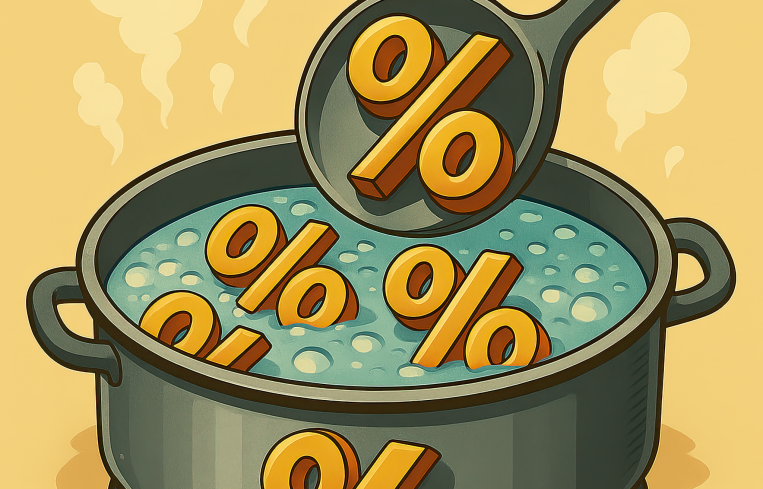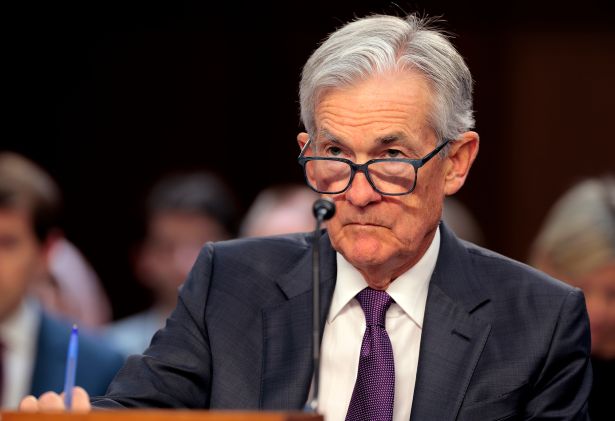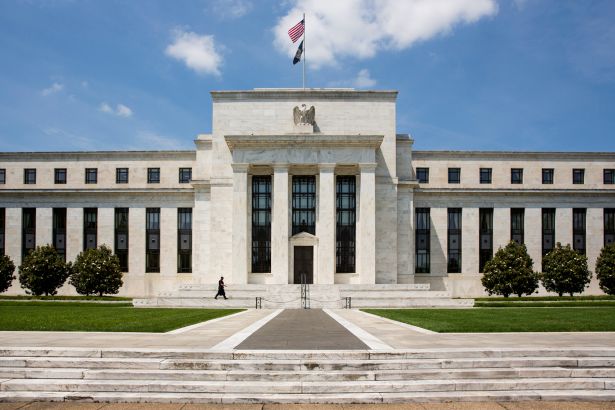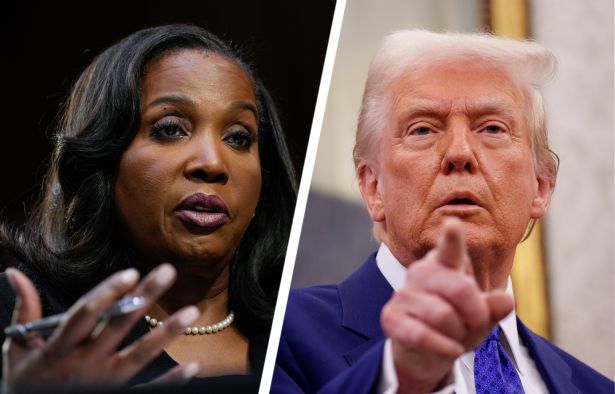A Commercial Real Estate Financing Comeback in 2025? Best Raincheck It.
How Federal Reserve policies and decisions out of the White House sent investors back to the sidelines
By Brian Pascus September 8, 2025 6:30 am
reprints
On Aug. 22, the world of commercial real estate held its collective breath as Federal Reserve Chairman Jerome Powell spoke from Jackson Hole, Wyo. Here, the nation’s chief central banker confirmed what many insiders have pined for, and what President Donald Trump has often inelegantly demanded: Interest rates will be cut this year.
If this sounds familiar, it’s mainly because a similar situation played out last fall, when Powell announced on Sept 18, 2024, that the Fed would cut interest rates for the first time since March 2020 — and nearly three years after it began a calculated battle of economic warfare against inflation, which saw the federal funds rate rise 0.25 percent in March 2022 to 5.25 percent by June 2024, its highest level in 17 years.
When speaking from Jackson Hole one year ago, Powell signaled to investors that the federal funds rate — an interbank lending rate that doubles as the economy’s benchmark short-term interest rate — would fall to 4.4 percent by the end of 2024 and reach as low as 3.4 percent by the close of 2025, so long as the economy evolved in a positive fashion.
Alas, if only words were tokens of truth in economics.
“If you were sitting here a year ago, you’d think the interest rate environment would look different after the first or second quarters of 2025, and it hasn’t looked different at all,” said Eric Enloe, senior managing director at Partner Valuation Advisors, a CRE advisory firm.
Today, even after Powell’s forward guidance, the federal funds rate stands between 4.25 and 4.5 percent, while the interbank lending rate used for overnight trading, the Secured Overnight Financing Rate (SOFR), sits at 4.39 percent — not quite the 3 percent mark Powell predicted.
And, as they vainly waited for a much-promised interest rate to arrive, commercial real estate players reluctantly returned to the sidelines. CRE transactions declined 19 percent year-over-year in the first quarter of 2025, and increased by only 3.8 percent year-over-year in the second quarter of 2025, according to the Altus Group, a CRE analytics firm.
“The Fed’s own survey suggested there would be further cuts to come, but when those didn’t materialize, there was then more delayed optimism,” said Jay Parsons, chief economist at JPI, a multifamily investment firm. “We’re waiting longer for that environment to improve where we can see more deal-making make sense again.”
While Powell implied last fall that he’d use his powers to open up liquidity across the economy, the market quickly sniffed out myriad elements of uncertainty lingering within any future calculation. The presidential election that saw Trump prevail over Vice President Kamala Harris was just weeks away; inflation lingered, albeit at more palatable levels; and the federal budget deficit remained preposterously large ($1.8 trillion in 2024 alone) — all of this even as unemployment stayed at a steady 4 percent amid an economy defined by gig jobs and part-time work.
What came next took everyone by surprise.
Just after Powell announced his intentions to cut, the 10-Year Treasury — the benchmark government security that doubles as the economy-wide cost of borrowing — defied conventional economic wisdom and immediately spiked from 3.6 percent on Sept. 17 to 4.3 percent by Nov. 1. Over the next few months, as Powell held steady on short-term rates, Treasury yields fell to 4.1 percent in December, then rose to 4.8 percent in January, and dropped as low as 3.8 percent in April, before settling into what appears to be an equilibrium around 4.4 percent since then.
Through it all, CRE’s world of institutional capital has remained flabbergasted at the lack of consistency, or follow through, when it comes to both short-term and long-term interest rates, in the process invalidating the “stay alive until 2025” ethos that had been the assurance behind renewed transaction activity amid the troubled years of 2023 and 2024.
“Higher rates are not good for us, but what’s worse for us is volatility in rates,” said Tommy Lee, co-president and co-head of CBRE’s U.S. and Canada capital markets business. “When people can’t forecast confidently what rates will be in five to seven years, that’s what keeps people from making investments or performing transactions.”

The results have been mixed across the industry, especially since Trump announced his widespread global tariff agenda in April. U.S. investment sales volume reached $115 billion in the second quarter of 2025, far below the $260 billion second-quarter volumes the industry saw in the low-cost heyday of 2021. Multifamily generated a 39 percent growth in investment sales year-over-year, while retail and hospitality plunged by 14 percent and 20 percent, respectively, according to Altus Group research.
“Ultimately, CRE investors are making bets about economic growth and demand for various property types, and when the tariffs were announced in the first quarter, it created a lot of uncertainty in terms of where the economy was headed,” said Shlomi Ronen, managing principal at Dekel Capital, an investment and development firm in Los Angeles. “A vast majority of investors went to the sidelines and took the position of, ‘Let’s wait to see.’”
Even amid a jittery 10-Year Treasury yield, the industry has remained fixated on Powell’s initial indication that he wants to cut rates, so long as economic conditions provide him that opportunity. The simple psychological impact of a potential a rate-cutting cycle — which historically brings several rounds of cuts — has helped the investment sales market remain afloat, even as it’s treading water, and given the bravest investors a chance amid the dips and plunges of the 10-year, according to James Millon, co-president and co-head with Lee at CBRE.
“When [Treasurys] makes a dramatic move downward in terms of yield, we do see lots of disposition activity,” explained Millon, who noted that sudden declines in long-term rates allow borrowers to tap into accretive leverage by using debt to buy properties that generate cap rates higher than a loan’s interest rate. “It unlocks tons of investment sales activity because new buyers coming in can put positive leverage on day one, so we look for those moments in time where there’s a dip.”
So, as much as the Fed will determine commercial real estate’s future, the 10-year Treasury and several political calculations might hold more sway regarding the industry’s future than the oracles within the Eccles Building.
More money, more problems
The main issue confronting CRE and the present interest rate cycle is that the entire industry is almost universally financed by debt, a method of capital construction at the mercy of any and all rate fluctuations.
Justin Kennedy, co-founder and managing partner for lender 3650 Capital, reiterated that no asset class has escaped the economy’s fundamental shift in recent years, whether its retail and office getting turned upside down due to technology innovations and novel consumer preferences, or multifamily developers and operators finding projected rent growths couldn’t keep pace with risky floating-rate financings.
“Obviously, real estate has been under two pressures: the rate pressure and all the financing and valuation issues that go along with that in terms of a property’s ability to cover the spread,” Kennedy said. “The debt capacity of the assets flows directly into the valuation of the assets, so real estate is always going to face a big challenge because we use more debt than most industries.”
The 10-Year Treasury is broadly impactful on the debt capacity and valuations of most assets — due to the fact that most real estate is financed by long-term loans — while the short end of the curve, via SOFR and the Federal Funds Rate, impacts shorter-term financing structures like construction loans and loan-on-loan financings.
While Powell’s fall 2024 forward guidance created the impression that the market had entered a new phase in the monetary policy cycle, his lack of follow through harmed his standing with CRE investors, as much as it did with Trump, who took office in January under the same rosy assumptions regarding Fed policy. In truth, however, it can’t be emphasized enough how much Trump’s ad hoc tariff policy this spring forced Powell to pull back on any intended or projected interest rate cuts.
“There’s more uncertainty as it relates to the future outlook and it’s basically a lack of clarity, and investors want clarity,” said David Reynolds, president of investment management at multifamily giant Mill Creek Residential. “Fundraising has been challenging as investors are reluctant to commit to new vehicles until they have interest rate clarity, and every time we think we’re almost there something else happens — for example, tariffs.”
The ironic, if not tragic, aspect of all this is that the last thing Powell and his Federal Reserve governors aimed to create was a lack of clarity. Brad Case, chief economist for Middleburg Communities, emphasized that the Fed does not ever want any of its actions to come as a surprise, and that Powell and his lieutenants carefully calibrate each of their public statements so that the last thing that happens is the market is caught unaware by conclusions made within the central bank’s Federal Open Market Committee Meetings.
“People act as though the Fed is opaque, but they are trying very hard not to be opaque,” said Case. “They tell people their thinking in the past and in the future, and they’re trying not to provide any surprises.”
The Fed’s dual mandate to control inflation and mitigate unemployment often gets misconstrued with its potential functions across the wider economy. As any economist would tell you, there’s a material difference between the Fed’s rate targets (and how SOFR reacts to the short-end of the curve) and the impact those actions have on the long end of the curve, namely the 10-year Treasury, which is colloquially called “the world’s discount rate.” That’s because assets related to consumer and business debt are priced off its risk-free yield. And this longer-term interest rate is not set by Powell, but rather is priced every day by buyers and sellers of U.S. Treasurys, bonds whose price and demand correlate to U.S. fiscal deficits and the wider geopolitical universe.
“Credit markets reset every single day, and the markets and liquidity reset much faster in credit than it did in equity,” explained Millon. “Psychologically, ‘the cut that wasn’t’ required lenders and investors to generate free cash flow the old-fashioned way — operate assets and not rely on interest rate cuts to make certain levered returns.”
One aspect of the current rate regime that played into CRE’s hands was the fact that the 10-year Treasury basically remained (relatively) stable since Trump took office in late January, dropping no lower than 4 percent in late April and cresting no higher than 4.6 percent in late May.
Compare this to the nightmarish jumps the bond market took from fall 2021 to fall 2023, when the 10-year rose from 1.5 percent to 4 percent by October 2022 and then up to 5 percent by the following October.
“The upshot is the 10-year hasn’t strayed. It’s been volatile, but it hasn’t really drifted that far from 4 percent all year, and that’s one of the things the CRE market has latched onto,” said Ryan Severino, chief economist at BGO. “We’d like to see it go down, but at least it stopped generally going up.”
The rate stability around the 10-year, and even the begrudging acceptance among market players that Powell probably wouldn’t cut rates as much as he promised in late 2024, has allowed the transaction market to breathe rather than fight for air.
The overall U.S. investment sales market recorded 12,458 transactions valued at $182.4 billion in total dollar volume in the first half of 2025, with the entire year on track for a 1 percent decrease in sales and 6.6 percent decrease in investment volume compared to last year, according to Avison Young.
“Although there weren’t cuts that might have been anticipated, the reality is there has been stability with the 10-year Treasury that has provided the baseline foundation for transaction volumes to increase as the market continues to push forward,” Jeffrey Erxleben, president of Northmarq’s debt and equity platform.
Hidden hand
Although Powell does not have the same powers over the 10-year Treasury as he has over the federal funds rate, the Federal Reserve can actually influence the movement of long-term rates like those on the 10-year Treasury and the 30-year fixed-rate mortgage average.
This is because bond yields are inversely correlated to price, and the price of bonds is directly affected by the demand from buyers, and no one since the 2008 Global Financial Crisis has been as big a buyer — or has recently been as consistent a seller — of U.S. Treasurys than the Federal Reserve.

From 2008 to 2012, the Fed’s balance sheet rose from less than $867 billion to $4 trillion, mainly because the central bank engaged in an emergency, and unusual, practice of quantitative easing (QE). To lower the economy-wide cost of borrowing during a financial panic and its aftermath, and to bring liquidity back into the system, the Fed bought trillions of dollars worth of mortgage-backed securities (MBS) and Treasury bonds. That in turn drove demand for corporate borrowing and housing by bolstering security prices up while pushing yields down, making it more affordable to buy homes and finance deals with cheap debt.
“The other part of monetary policy is their holdings of assets,” explained Case. “What the Fed did after the 2008 crisis, all the way up to 2012, is they bought lots of mortgage-backed securities and 10-year Treasurys and said, ‘When we buy these and adjust our holdings, that pushes the rates down.’”
The Fed operated this exact same playbook, and even expanded it, following the onset of COVID-19 in early 2020. From February to June 2020, the Fed’s balance sheet grew from $4.1 trillion to $7 trillion, and rose to an all-time high of $8.96 trillion by March 2022.
This unprecedented growth of Fed assets necessitated a course correction once the pandemic came under control. So as the central bank battled inflation and the pandemic subsided, it engaged in Quantitative Tightening (QT), selling off approximately $2.1 trillion of long-term securities since March 2023, in turn killing demand for those securities, gutting their prices, and driving yields up.
“People don’t want to talk about it, but we have been running a QT program that primarily affects the longer end of the curve,” said Kennedy. “[The Fed] reducing its balance sheet by almost $3 trillion has unequivocally kept mortgage rates and Treasury yields in the long end higher than they would’ve been otherwise because it’s a steepener.”
Just look at the evidence. From March 2022 — beginning at the Fed’s peak and subsequent QT selloff — the 30-year mortgage rate rose from 4.16 percent to 7.22 percent in November 2023. In this same time frame, the 10-Year Treasury soared from 1.6 percent to 5 percent.
“The Fed’s job is not to help people afford homes. Their job is to manage the overall economy in terms of labor markets and inflation,” said Case. “To the extent that helping the homeowner market can contribute to that, great, but that’s not their job. It’s a tool.”
Others like CBRE’s Millon, while acknowledging the Fed’s role in initiating QE and QT, also emphasized that in the grand scheme of things — meaning the decades that preceded the GFC (yes, they exist) — the 10-year Treasury average soared higher than 4 percent, and actually sat around 7 percent for much of the 1990s and exceeded 11 percent for the first half of the 1980s.
“The point is getting investors’ minds around the fact that, from a historical perspective, 4.25 percent is not widely off from where it’s been,” said Millon. “It’s that we’re comparing it to a moment in time where interest rates were the lowest they’ve ever been.”
Even if investors were to come around to a world in which short-term and long-term rates sat above 4 percent from here on out, no one’s mind matters more in America today than Donald J. Trump, and he is doing whatever he can, consequences be damned, to drive interest rates lower.
A new battle
Not since Andrew Jackson waged war against Nicholas Biddle and the Second Bank of the United States during the 1830s has an American president taken on a financial institution the same way Trump has come after Powell, a Federal Reserve chair he elevated in 2018 and whom President Joe Biden kept on.
Jackson, for his part, emerged victorious, ending central banking in the United States for 80 years and setting off a buccaneering form of localized 19th-century capitalism that saw the unregulated expansion of railroads, the growth of the American West, and the creation of Gilded Age fortunes. But the lack of central banking control over monetary policy also led to numerous cycles of boom and bust, and caused extended depressions in the 1830s, 1870s, 1890s and 1930s.
Trump, in a break from over 100 years of precedent, has openly demanded Powell cut short-term interest rates, and has taken to bullying him in public and private. In recent weeks, he’s considered firing Powell (a legally dubious move) and has initiated a pressure campaign against one of the seven Fed governors, Lisa Cook, accusing her of mortgage fraud and initiating a Justice Department investigation (also legally dubious). Powell, whose second four-year term expires in May 2026, has remained mute on these actions.

Market watchers aren’t so sure the economy will escape from this unprecedented battle over monetary policy without a severely altered landscape. BGO’s Severino said if Trump prevails in this fight, in this manner, confidence in the Fed will plummet, markets will become more volatile, credibility on Fed forward guidance will diminish, and monetary policy out of the Eccles Building will likely run counter to orthodox economic reporting.
“Not to be remotely political … but relative to Fed operations now, you’ll introduce more uncertainty and volatility and less confidence in the Fed’s guidance and messaging moving forward,” Severino said. “It’s fair to say that would be problematic for markets.”
Others like 3650’s Kennedy dismissed these concerns, pointing out that monetary authority in this country has always been tied to politics, whether it goes back to Jackson’s battle with Biddle or the creation of the Federal Reserve in 1916 in the aftermath of the Panic of 1907.
“I think it was unequivocally a political decision to create the Fed, and the fact that it’s now under political influence is nothing new,” said Kennedy. “I’m not going to light my hair on fire because the Fed is under pressure.”
One wildcard that may force Powell’s hand in the coming weeks: poor jobs numbers. The bureau of labor statistics reported on Sept. 5 that the U.S. economy added only 22,000 jobs in August as unemployment rose to 4.3 percent, its highest level since October 2021.
Regardless of what happens in the near term, Powell is term-limited, and Trump will select his successor next year, likely initiating a return to the easy money monetary policies that characterized the 2010s. The only difference is this decade now has caught the bug of inflation, U.S. budget deficits appear trapped in $1 trillion death spirals, and the national debt keeps growing and growing — all of which will wreak havoc on long-term yields, and spook the market.
Enloe said he has “major concerns” on this front, and expects that CRE owners and investors need to get used to a 10-year Treasury with a 4 percent or 5 percent base rate going forward.
“Cheap debt is a drug habit, like cocaine,” he said. “We’re trying to wean off all this cheap debt, and it’s just not happening.”
Brian Pascus can be reached at bpascus@commercialobserver.com.



